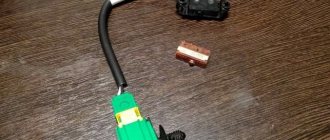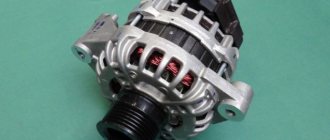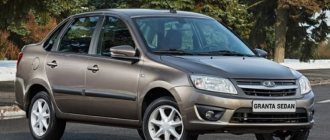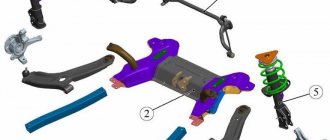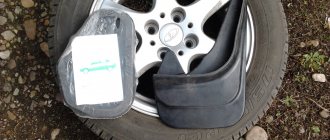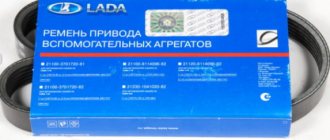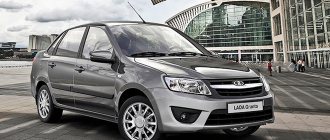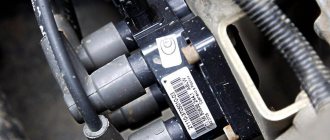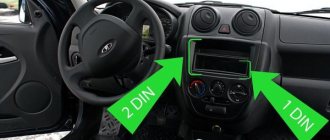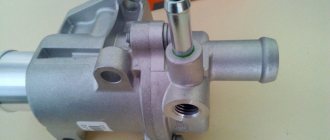Creaks are present even in the basic configurations of the Lada Granta Liftback, despite being equipped with noise and vibration insulation. This causes significant discomfort to the driver while driving.
Eliminating squeaks is not an easy, labor-intensive, and costly procedure. Not all owners willingly agree to do this in a service station. In order to save money, car enthusiasts practice doing noise reduction with their own hands. Read below about how to do this on a Lada Granta Liftback.
What material is used to eliminate squeaks?
- bitoplast;
- anti-creak
Few owners know the use of each material; they are often considered identical, but this is not so.
Anti-creak is often called “madeline”, after the same name of the component included in the main composition. Madeline is a thin material, not intended for noise and vibration insulation. Suitable only for eliminating squeaks.
Bitoplast - also known as “Shumka”, has a thick fiber structure, is used primarily to reduce noise and vibration levels. It is not used as an anti-skripin. Although they sell it in stores as a universal remedy, which is fundamentally wrong.
Related link:
Comparative review of the technical characteristics of Grants Liftback, Renault Logan and Renault Sandero
How to determine the cause of extraneous sounds
The appearance of extraneous sounds means that some mechanism has become unusable. Do not delay this issue until strange sounds lead to serious and expensive repairs.
Sound Source Localization
First you need to understand where the noise came from. To do this, warm up the car and listen carefully to the engine compartment. Here you can understand from which mechanism the extraneous sound comes from.
Car stethoscope
Listen to how the car behaves on the road, whether there is a hum when accelerating or braking. Extraneous noise may occur when turning.
There is a special device for “listening” - a car stethoscope, with which it is easy to determine where the noise is coming from. The operating principle of a car device is the same as that of a medical stethoscope.
Most likely malfunctions
The table shows typical problems signaled by sound.
| Character of sound | Possible faults |
| Rumble | ● Wheel bearing hums ● Transmission malfunction |
| Knock | ● Play in ball joints ● Steering rack and pinion wear ● Wear of shock absorber pads ● Wear of support bearings ● Loose suspension fastenings |
| Grinding | ● Poor quality or worn brake pads ● Deformation of the brake disc guard ● Wheel friction on the arch ● Uneven wear and scoring on the disc or drum. |
Diagnostics on a lift
A lift will help check the suspension for play. Turn each lever in different directions one by one. If serious play appears, repair the identified damage. It is from this node that the extraneous sound is emitted.
Eliminating squeaks in the cabin
Upper side trims
- Carefully pry up the plastic cover and remove it.
- We glue several strips of madeline onto the metal stand.
- We fix the laid electrical wiring with insulation.
- We press the overlay. If you don’t want to glue it to metal, apply Madeleine to plastic.
By analogy, we remove the squeak on the right pillar.
Torpedo in places where fasteners are fixed
On the left and right sides, the torpedo is pressed with two screws under a cross-shaped bit. The “noise reduction” process is as follows: unscrew the screw, place a plastic washer (ring) under the support. The height should be in the range of 0.3 - 0.5 mm. Exceeding the height does not guarantee a tight fit of the torpedo in its normal place.
We repeat a similar procedure on the torpedo mount on the right side.
The front part of the deflector grille, radio, stove heater speed controller
The procedure involves removing the plastic trim from the front of the torpedo and gluing Madeleine strips around the perimeter. In this case, we do not touch the inside of the panel, where it is necessary to additionally glue the bitoplast.
We do not recommend fitting it “with glue”, since if removal is necessary, the structure will not be removable.
Internal “stuffing” under the dashboard
To remove extraneous noise, you will need to completely dismantle the front instrument panel, remove the wiring blocks, disconnect the stove heater control levers, and deflectors.
- After the panel is removed, we proceed to pasting the back of the torpedo with bitoplast, wrapping the levers of the drive mechanisms in an insulating layer.
- We put the electrical wiring in a fireproof corrugation and tighten it with clamps.
- We assemble the structure in reverse order.
Door card
We disassemble the door trim if noise and vibration insulation measures were not taken when installing the acoustics. If the work was carried out at a service station, then there will be no such problem.
Related link:
Lada Granta Liftback Comfort: is it really comfortable?
We glue madeline in the form of strips around the perimeter of fixing the acoustics. If necessary, cut out strips along the outer perimeter of the door card.
Trunk lock fixing shackle
There is only one recommendation - replace the bow with a new one, since this is a manufacturing defect.
Side pads made of plastic
- Use a plastic object to pry up the plastic casing and remove it.
- We glue anti-squeak strips to the inside around the perimeter.
- We install it in its original place.
If the lining is clearly deformed, we replace it with a new one, since gluing it on Madeleine will not give a positive result.
Upper luggage compartment
Creaking and vibration of the shelf are eliminated by gluing bitoplast strips on the inside. Lubricate the fastening points on the screws with silicone grease.
Where do extraneous sounds come from?
The causes of extraneous sounds are varied. Some problems can be solved on your own.
Dirty pads or their critical wear
An unpleasant squeal can be heard in the area of the front wheels when braking. The pads consist of a friction clutch and a metal base. During braking, the clutch wears off and the metal base comes into use. A characteristic sound of grinding metal appears.
Dirty pads
If new pads are installed, but the unpleasant noise remains, do not panic. This may be due to uneven disc wear. As you move, the pads will rub in and the extraneous noise will disappear. A problem with the rear pads can occur if they are installed incorrectly. Watch how the pads are installed.
Steering faults
The load has a strong influence on the ball joints. If they are worn out, a characteristic knocking sound is heard in the area of the right and left wheels. Immediate diagnosis is necessary.
If the caliper breaks, you will hear a squeaking and grinding noise. This is caused by jamming of the working cylinder or caliper guides. The pads are constantly pressed. This is caused by:
- a leaky boot that could become clogged with dirt;
- oxidation of the cylinder itself or the guides, which prevents it from returning to its original position.
Steering faults
This problem can be diagnosed by feeling the deterioration of the roll and slightly pulling towards the pinched wheel.
Mechanical damage
Large uneven roads wear out the suspension, which can also be indicated by noise from the front of the car. The problem could be a worn wheel bearing or CV joint.
The protective shield (metal casing of the brake disc) may be deformed.
Incorrect wheel size
A grinding noise may appear after installing wheels of larger diameter when they rub against the arch. It is necessary to install a tire size that meets the requirements for a particular vehicle.
The rear wheel of the Lada Granta shuffles
Dimon wrote: Sometimes something shuffles on my left side that I don’t know and don’t want to know, for some reason it only appears in dry, warm weather.
hmm, but mine is wet and dirty. I decided it was dirt. scored. Now that it has become clean and dry, this sound has become a kind of squeak, but from the front. I looked at the pads - almost like new. x.z. what's happened
Has anyone encountered this problem?
I placed washers under the cotter pin that holds the lever on the rear block (so that there is no loose hanging on the axle)
After changing the rear wheels (tires and wheels), I also started to hear a knocking noise, as it turned out it was the bolts that secure the wheel that were knocking (they rubbed against the brake pads), I solved the problem by grinding off a 2-4 mm bolt (bluntly with a file)
PS> If the bolt is rubbing against the pads, you can easily find out by unscrewing the bolt and looking at it; if it is rubbing, then characteristic wear from friction will be visible there!
Friction also occurs after replacing old brake pads with new ones, simply because they are new and will rub against the drum for some time!
After changing the rear wheels (tires and wheels), I also started to hear a knocking noise, as it turned out it was the bolts that secure the wheel that were knocking (they rubbed against the brake pads), I solved the problem by grinding off a 2-4 mm bolt (bluntly with a file)
PS> If the bolt is rubbing against the pads, you can easily find out by unscrewing the bolt and looking at it; if it is rubbing, then characteristic wear from friction will be visible there!
Friction also occurs after replacing old brake pads with new ones, simply because they are new and will rub against the drum for some time!
the bolts that secure the wheel were knocking (they were rubbing against the brake pads),
, I thought about tightening the handbrake, although it already works at the 3rd click.
In fact, this partially solves the problem, I adjusted it to 2 clicks, but still sometimes something happens, and sometimes it’s absolutely silent, in short, I’ve put some crap on it because it’s unclear and doesn’t interfere.
nonsense, the bolts rub against the handbrake cable
If you consider the wear of the bolts that I had, then the handbrake cable would have been worn to dust from such friction!
Source
Comments • 49
Beautiful Pavel, I had the same problem at 100 thousand miles. I did as you showed, the creak disappeared!!
There are already a lot of comments about music, I join. I only understood from the comments what was poured into the syringe. Well, in general, thanks, we’ll give it a try.
What kind of liquid should I put in there? Oil ? Nigrol?
Thanks to the author of the video. I spent a long time looking for what was creaking, the fault was the support bearing, after watching this video, it squeaked like mine, even on the same wheel. I went and bought a syringe of 5 cc (too bad the needle was thin), and injected probably 1.5-2.0 cc of a “faith” injection. Oh my god it doesn't squeak anymore. But I still ordered reinforced ball joints and will change them. The car (Kalina 2, produced in 2022) covered 70,000 km. Once again, respect and respect to the author.
How many cubes should the dose be?
I have a 2022 Grant Fl, mileage 3000, the chassis is already creaking, what the heck..
@Egor Kuznets, I went for a ride today, including several times driving along the fucking path from the house to the asphalt and back. The good thing about silicone is that it retains normal softness during temperature changes. I’ll ride like this for now, if it creaks again, then I’ll come up with something else. I was very surprised by the fact that I didn’t really have to tighten anything in the suspension and chassis. I remember the new seven was turning almost the entire bottom.
@Vadim Kryuchkov the handbrake cable can be pulled out of the bracket, where it rubs against the body. And secure with zip ties. People do this right away. I tried to put rubber bands on it, but after a heavy rain it started squeaking again.
@Egor Kuznets, there is no market, our concern is everything. Well, okay, when I took bucket 21074 15 years ago, well, there didn’t seem to be much to ask. A tractor is a tractor, although unlike the Soviet-era sevens, the new one turned out to be just brutal crap. And here it’s like it’s not a big deal. After 15 years, it’s like you’ve gone to heaven. Everything works, there are brakes, a heater, the steering holds, as if you were driving on rails. A song, not a car. And I drove a hundred kilometers and I started listening to bugs, crickets, spiders. I made noise from everything, from seven to ten, otherwise it’s impossible to drive. The noise from the wheels is hellish, especially in winter on asphalt. I’ll make noise with this one over time, but the car was bought in principle so that for five years it would be stupid to pour gasoline and change the oil, and not crawl under it. My mileage per year is less than 10 thousand now. That’s why I tensed up when the new car started creaking. Eliminated this creaking and croaking yesterday. I drove it into the pit and stretched everything that was below and that could be pulled under. I inserted spacers from food-grade silicone hose into the brackets holding the handbrake cables.
@Vadim Kryuchkov and regarding quality, this is a small matter, easily resolved. Any car requires love and care.
@Vadim Kryuchkov you’ve gotten really crazy here. Don't worry, it won't fall apart. For 6 years I have been driving Kalina 2 on such roads that after overloaded trucks in the heat, all that remains is asphalt. It’s really a pity to ruin a foreign car on such roads for 1.5 - 2 lamas. And it’s tall and doesn’t catch on the bottom.
You turn up the music in the car and not in the video, and the squeaks will disappear
Headlining
To check, you can insert a plastic card into the slot of the panel that is under suspicion, and then take a ride and listen to see if the sound disappears.
To check, you can insert a plastic card into the slot of the panel that is under suspicion, and then take a ride and listen to see if the sound disappears.
It is better to carry out a more painstaking search with an assistant, who, while moving, begins to press different panels of the car with his hands, depriving them of mobility or at least changing the frequency of oscillations. Most often, in this way it is possible to localize vibrations at least to the accuracy of the upholstery part. Next, you can simply try to “polish” the part.
Knocking and creaking from the rear when braking on LADA cars
Have you ever encountered a situation where, when braking, extraneous noise appears from behind the car (knocks, impacts, squeaks)? This problem can occur on any Lada car (for example, Kalina, Priora, Granta, Largus, Niva, Vesta or XRAY). Let's talk about possible solutions to this problem.
Most often, extraneous noise from the rear when braking occurs when consumables are worn out (brake drums or pads No. 3). A knocking noise may occur when the pads are biting. When disassembling the brake drum, also pay attention to the condition of brake cylinder No. 1 , which may jam. We replace the pads with new ones.
In some cases, the culprit is worn tension springs No. 2 and No. 7 , which have stretched or burst over time. As a result, the normal operation of the rear brakes is disrupted.
Another reason for a knock at the rear may be the handbrake cable or its spring No. 14 that has jumped out . Inspect all the parts and tighten the handbrake.
Sometimes the cause of the problem may be a loose rear wheel bearing . In this case, noise (shuffling and tapping) from the rear appears during braking at low speed.
The last reason that many car owners have had to deal with is wheel bolts that are too long . For example, a longer wheel lock catches when braking and a knocking noise appears. Solution: replace it with a shorter one.
On B0 platform cars (Lada Largus, XRAY, Renault Logan, Sandero, etc.) over time, squeaking appears in the rear brake mechanisms. Reason: the pad is rubbing against the brake shield . We remove the clamp and remove the block, we see the place of wear. We clean these problem areas and lubricate them with grease. More details on the video:
Have you ever encountered a knocking noise from the rear when braking your car? How did you resolve this issue? We solve such problems in the comments or on the forum. And if the creaking noise when braking comes from the front, then most likely this noise is coming from the front brake pads, which should be replaced in pairs with better ones.
Source

